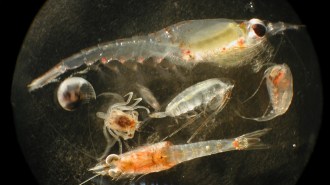The Costs of Meat and Fish
March 13, 2008
“Can Meat and Fish Consumption Be Sustainable?” That’s the provocative title of a press release just sent to us by the Worldwatch Institute, a small but by now venerable think tank that focuses on natural resource issues.
It’s also the theme of a chapter in Worldwatch’s 2008 State of the World report, its 25th annual book-length analysis of resource trends and economics. Here, its analysts take on the substantial—and often hidden—costs of producing animal protein to satisfy human hunger.
In 2006, Worldwatch reports, “farmers produced an estimated 276 million tons of chicken, pork, beef, and other meat—four times as much as in 1961.” As for fish: Some 140 million tons were hauled in globally during 2005, the most recent year for which data are available. “That was eight times as much as in 1950,” note Brian Halweil and Danielle Nierenberg, the chapter’s authors.
Part of the growth in production reflects a growing demand, fueled by world population and growing wealth that allows meat consumption even within formerly impoverished nations. However, per capita consumption has also been rising. For meat, it’s doubled over the past 45 years; fish consumption quadrupled over a 55-year span.
Bottom line: “meat and seafood are the two most rapidly growing ingredients in the global diet,” Halweil and Nierenberg find, and “two of the most costly.” Demand for both are slated to go the way of oil—up, up, up, with prices following—as incomes in China, India, and hosts of developing countries rise.
Industrial meat production and fish harvests have dropped the economic cost of animal proteins in recent decades. But much of that fiscal savings has come at the expense of the environment. Wastes are not captured and destroyed or recycled. They’re allowed to run into the ground or waterways, degrading ecosystems all along the way. There are costs to this that are not captured in traditional accounting—but they’re costs nonetheless.
Anyone who has tried fishing in the Gulf of Mexico’s annual dead zone has experienced one cost of allowing livestock wastes from the upper Midwest to flow through the ground and into waters that feed the mighty Mississippi—and Gulf (See Limiting Dead Zones). Anyone who lives with the pervasive stench downwind of animal feedlots knows there’s a cost that these neighbors are being asked to subsidize with their discomfort—and perhaps health.
Fishers, in recent years, have been mining the ocean’s top and middle predators, substantially distorting the balance of ecosystems (SN: 6/4/05, p. 360). The net primary productivity of the oceans probably hasn’t changed much: that is to say, about the same mass of living cells probably inhabits it. However, instead of tuna, cod, sharks, and trout, the bulk of the mass may be shifting to alewives, smelt, jellyfish, and algae (see How Low Will We Go in Fishing for Dinner?: http://www.sciencenews.org/pages/sn_arc98/2_7_98/fob1.html). One solution, fish farming, has proven moderately successful—but can also prove enormously harmful to nonfarmed species and the environment generally.
“Part of the reason that livestock and fish farms have become ecological disasters is that they have moved away from mimicking the environment in which animals exist naturally,” the Worldwatch report maintains.
There’s another problem as well. People the world over want to eat the same few species—cows, pigs, and lambs, salmon, tuna, and trout—even if their own environment cannot support the production of these animals. Moreover, as relatively large and high-in-the-food-chain animals, these species grow at the expense of hosts of plants, animals, and other energy inputs. The land and energy needed to produce 1,000 calories of grain, legumes (like soy), or algae is a fraction of what it takes to produce 1,000 calories of beef or catfish.
Many people don’t want to eat just greens, grains, and pulses (like beans). In truth, I don’t.
However, there is another source of animal protein that may prove dramatically more sustainable than fish and hoofed livestock. Insects.
Alright, it may take a bit of work to wrap your head around the idea of this—especially if you grew up in the States. We’re talking ants, grasshoppers, and beetles.
There was a time that the arrival of hordes of locusts blackening the skies was a time for rejoicing. Hungry farmers would see this as a smorgasbord of animal protein that could be gathered by the bucketsful. Eaten raw, fried with onion and chilis, or roasted for consumption throughout the months ahead, this was nutritionally high-quality animal protein. And you didn’t have to chase it. It came to you.
Those old enough to remember shipments of food aid to starving masses in Ethiopia and Somalia during the ‘70s and ‘80s may also remember scandals describing hundreds if not thousands of tons of wheat flour that arrived at its destinations spoiled by infestations of beetles, notes Victor B. Meyer-Rochow of Jacobs University in Bremen, Germany. “But that’s really nonsense,” he argues, because those beetles were nutritionally more valuable than [the grain] that people were trying to protect.”
Bottom line, diets throughout the globe have been changing. And if we all want reliable access to animal protein, we may have to embrace mini-livestock—the six-legged kinds.
You’ll be able to read more about this topic—a serious one—soon in the pages of Science News and at Science News for Kids, our online sister publication. So stay tuned.
And who knows, one day we may read that termites, popular for millennia in nations throughout the world, have become a growth industry for New Orleans. It’s home to permanent hordes of the Formosan variety (See Munching Along)—insects that weathered Hurricane Katrina far better than did the region’s tax payers.






